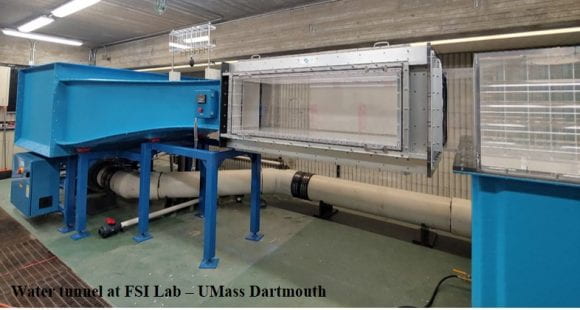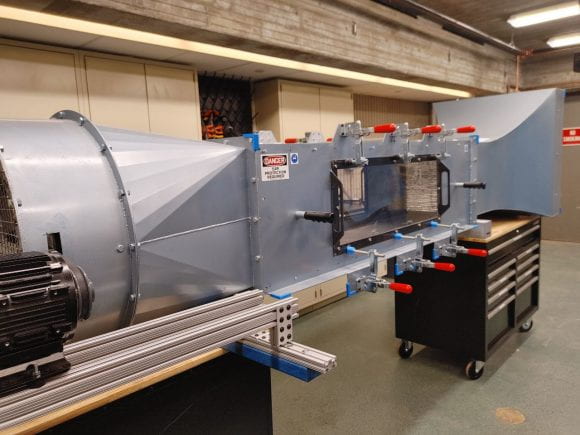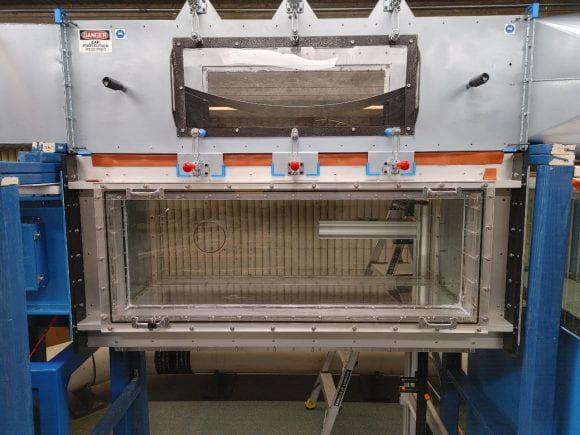Facilities
| Re-circulating Water Tunnel Facility: A re-circulating water tunnel, manufactured by ELD Inc., is available to use at the Laboratory for Fluid-Structure Interactions Studies (FSI Lab) at the Mechanical Engineering Department at UMass Dartmouth. The water tunnel has a test-section of 45 cm by 45 cm by 150 cm. The flow velocity can be varied from 0.03 m/s to 1.0 m/s, and the turbulence intensity of the tunnel is less than 1\%. This water tunnel is equipped with a gravity driven dye and hydrogen bubble imaging system for flow visualization.
|
| Subsonic Wind Tunnel: A subsonic wind tunnel is available at FSI lab. The closed-section wind tunnel has a test section of 45 cm ×45 cm ×150 cm. The flow velocity can be varied from 1.0 m/s to 20 m/s. The wind tunnel is equipped with two flow measurement devices: a hot wire anemometer running in parallel with a vane anemometer to accurately measure the magnitude of the velocity of the airflow through the test chamber.
This subsonic wind tunnel is designed such that it can be added as a module on top of the re-circulating water tunnel for experiments that requires two-phase flow testing.
|
| Time-Resolved Volumetric Particle Tracking velocimetry (TR-PTV): At the FSI lab, we have access to an optical method of quantitative flow visualization using particle tracking velocimetry (PTV). Our state-of-the art system consists of particles illuminated by a 300 × 100 mm^2 LED (FLASHLIGHT 300 array, LaVision). The recording system is a four-camera Minishaker box (LaVision), equipped with 8, 12 and 16 mm focal length lenses placed at a working distance from the central vertical plane of the volume of interest. The flashlight and set of cameras are triggered simultaneously using a LaVision Programmable Timing Unit (PTU) driven by DaVis 10 acquisition software. PTV data processed by the Shake The Box (STB) algorithm allows for the time resolved, three dimensional (3D) 3 components (3C) measurement of Lagrangian velocities for a large number of tracked particles in a volume of interest that can be used for quantitative flow visualization for the water/wind tunnel experiments. The video below shows our measurements of vorticity and velocity field around a circular cylinder, undergoing large-amplitude vortex-induced vibration at Re=2,800.
|
| High Speed CMOS Cameras (Sony IMX252LLR/LQR): Two high speed cameras with high speed Core DVR are available at the FSI lab. The two high speed cameras have advanced CMOS image sensors with a global shutter function and a 3.45 $\mu m$ pixel that is the smallest class in the industry. This small-sized 3.45 $\mu m$ pixel realizes higher sensitivity and lower noise than that of the existing 5.86 $\mu m$ pixel products, and achieves high picture quality, high resolution and high-speed imaging without focal plane distortion. This setup will give us the ability to record two synchronized recordings at 2048 ×1088 resolution at frame rates up to 264 fps and 755 fps at 640 ×480 pixel resolution. The Core DVR allows for reliable uncompressed video recording, direct to solid state media. The DVR core provides a precise time stamping and camera synchronization. The cameras are C-mount, 10 bits pixel bit depth with 80 MHz Pixel Clock output.
The high-speed cameras are used for (1) spanwise structural response measurements of flexible structures undergoing large amplitude oscillations, and (2) for qualitative flow visualization, using hydrogen bubble technique. The video below shows our flow visualization of the periodic vortex shedding (2S pattern) in the wake of a circular cylinder undergoing large amplitude vortex-induced vibration at Re=1,200. |
| Other tools and equipment: At FSI lab, we also have a set of Non-Contacting Displacement Sensor (Panasonic HL-G125), A 6-axis force/torque sensor (ATI Nano17 IP68), a high accuracy motorized translation stage (V-508 PIMag®) combined with a one-axis PIMag® motion controller for magnetic direct drives, a Creality Ender 5 Pro 3D Printer, multiple desktop workstations and a Dell Precision workstation which is a high-end nearly server class computer with the Xeon CPU, 4TB hard drives, and software, such as, DaVis, MATLAB/SIMULINK, and SolidWorks. |




